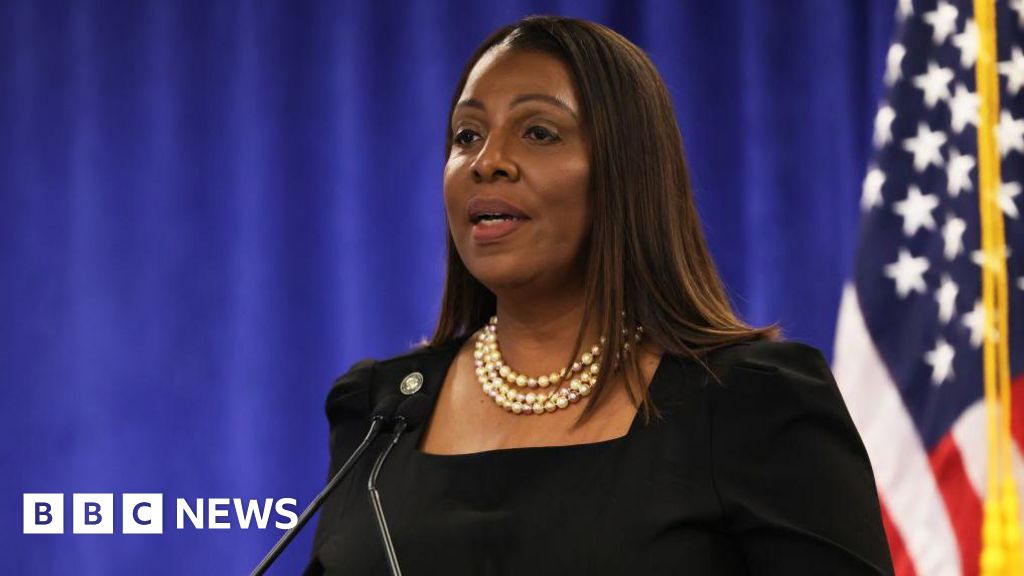States Sue Trump Administration Over Tariff Authority
A coalition of states is challenging the president’s power to impose tariffs, citing constitutional concerns.
A group of a dozen U.S. states has filed a lawsuit aimed at blocking tariffs imposed by former President donald Trump, alleging that the tariffs have “upended global trade.” The suit, spearheaded by New York’s governor and attorney general, contends that Trump lacked the necessary authority to enact the levies, arguing that such trade measures require approval from the U.S. Congress.
The lawsuit, filed with the United States Court of International Trade, names twelve states as plaintiffs. While the original action occurred during the Trump administration, its effects continue to ripple through the U.S. economy, prompting renewed legal scrutiny.
White House Response and Justification
The Trump White House previously dismissed such challenges, accusing New York Attorney General Letitia James of “prioritizing a witch hunt against President Trump over protecting the safety and wellbeing of their constituents.”
Former White House spokesman Kush Desai defended the tariffs, stating that the “administration remains committed to using its full legal authority to confront the distinct national emergencies our country is currently facing—both the scourge of illegal migration and fentanyl flows across our border and the exploding annual U.S. goods trade deficit.”
Legal Basis of the Challenge
The core of the lawsuit questions Trump’s invocation of the International Emergency Economic Powers Act (IEEPA), a 1970s law, as the basis for imposing tariffs. The lawsuit asserts that tariffs must be approved by Congress and that the IEEPA was improperly used.
“By claiming the authority to impose immense and ever-changing tariffs on whatever goods entering the United States he chooses, for whatever reason he finds convenient to declare an emergency, the President has upended the constitutional order and brought chaos to the American economy,” the lawsuit states.
Trump had invoked the IEEPA as justification for tariffs against China, Mexico, Canada, and other countries.
Under the IEEPA, a president can act “to deal with any unusual and exceptional threat, which has its source in whole or substantial part outside the United States, to the national security, foreign policy, or economy of the United States,” provided a national emergency is declared. Though, the lawsuit argues that the act does not grant the president the power to impose tariffs. Citing congressional research,the lawsuit notes that IEEPA has never been used to issue tariffs by any president.
Similar Challenges and Past Actions
California previously filed its own lawsuit against the Trump administration over tariffs, similarly arguing that Trump lacked the power under the IEEPA to impose them. Other lawsuits have also challenged Trump’s authority to use that law for the levies. These legal actions reflect a broader concern about the executive branch’s authority over trade policy.
Trump initiated tariffs on various global trading partners, aiming to address what he perceived as unfair trade deficits between the U.S. and other nations. These tariffs led to retaliatory measures from other countries, creating trade tensions that continue to affect U.S. businesses and consumers.
On April 2nd,in an event billed as “Liberation Day,” Trump announced “reciprocal” tariffs on nations across the world.Following a market backlash, he announced a 90-day pause on the tariffs and “lowered the rate to 10% for most countries.”
However,this pause did not extend to China. Trump stated that China showed a “lack of respect” and was retaliating. Consequently, the U.S. imposed a 145% tariff on goods imported from China, escalating the trade standoff and unsettling global markets.
The White House also imposed 25% tariffs on certain goods from Mexico and Canada, impacting trade relations with key U.S.neighbors and partners. these tariffs, while partially rolled back under subsequent agreements like the USMCA, left a lasting impact on supply chains and import costs.
| Country | Tariffed Goods (Examples) | Initial Tariff Rate | Current Status (as of april 2025) |
|---|---|---|---|
| China | Electronics, machinery, textiles | Up to 145% | Some tariffs remain; ongoing trade negotiations |
| Mexico | Steel, aluminum, agricultural products | 25% | Largely resolved under USMCA |
| Canada | Steel, aluminum, lumber | 25% | Largely resolved under USMCA |
Debate Over Presidential Authority
A key point of contention is whether the IEEPA grants the president unilateral power to impose tariffs under the guise of national security. Legal scholars are divided on this issue. Some argue that the IEEPA was intended for genuine national emergencies, such as wartime or major economic crises, and not for addressing trade imbalances. They argue that using it for tariffs circumvents Congress’s constitutional authority over trade policy.
Others argue that the president has broad authority over foreign policy and national security, and that the IEEPA provides a legitimate basis for imposing tariffs to protect U.S. economic interests. They point to past instances where presidents have used similar emergency powers to address economic challenges.
The lawsuit brought by the states challenges this broad interpretation of presidential power, arguing that it undermines the separation of powers and could lead to abuse. The outcome of the case could have significant implications for future trade policy and the balance of power between the executive and legislative branches.
Economic Ramifications and Counterarguments
While proponents of the tariffs argued they woudl protect American jobs and industries, critics contended that they ultimately harmed the U.S.economy by raising prices for consumers and businesses. Retaliatory tariffs from other countries also hurt American exporters, leading to job losses in some sectors.
One counterargument to the states’ lawsuit is that the tariffs, while possibly disruptive in the short term, were necessary to level the playing field with countries that engage in unfair trade practices. Some economists argue that the tariffs forced other countries to negotiate more favorable trade deals with the U.S., ultimately benefiting the American economy.
However, data from the U.S. International Trade Commission suggests a more nuanced picture. While some industries may have benefited from the tariffs, others experienced significant declines in exports and increased costs for imported inputs. The overall impact on the U.S. economy remains a subject of ongoing debate.
Impact on American Consumers
The tariffs have had a direct impact on American consumers, leading to higher prices for a range of imported goods, including clothing, electronics, and appliances. Businesses that rely on imported materials have also been forced to raise prices, contributing to inflationary pressures.
For exmaple, the tariffs on steel and aluminum increased the cost of manufacturing cars, appliances, and other products. This led to higher prices for consumers and reduced the competitiveness of American manufacturers in global markets.
The lawsuit brought by the states argues that these price increases disproportionately affect low-income Americans, who spend a larger share of their income on essential goods. By challenging the legality of the tariffs, the states aim to provide relief to consumers and businesses that have been harmed by the trade policies.
current Status and Future Outlook
As of April 2025, the lawsuit remains pending before the United States Court of International Trade. The court will need to consider the legal arguments presented by both sides and determine whether Trump exceeded his authority by imposing the tariffs. The outcome of the case could have significant implications for the future of U.S. trade policy and the balance of power between the executive and legislative branches.
Even with a change in administrations, the case highlights the enduring questions around executive power and trade that continue to shape American economic policy.
FAQ: Tariffs and Presidential Authority
- What is the International Emergency Economic Powers Act (IEEPA)?
- The IEEPA is a 1977 law that grants the president authority to regulate international commerce during a declared national emergency, allowing them to respond to threats originating outside the U.S.
- Has the IEEPA ever been used to impose tariffs before the Trump administration?
- No,congressional research indicates that the IEEPA has never been used by any president to impose tariffs prior to the Trump administration.
- What are the main arguments against the tariffs imposed by the Trump administration?
- The main arguments are that the president lacked the constitutional authority to impose the tariffs without congressional approval, and that the IEEPA was improperly invoked to justify the levies.
- How have the tariffs affected American consumers?
- The tariffs have led to higher prices for a range of imported goods, including clothing, electronics, and appliances, impacting household budgets.
- What is the current status of the lawsuit against the tariffs?
- As of April 2025, the lawsuit remains pending before the United States Court of international Trade.
What is the International Emergency Economic Powers Act (IEEPA) and why is it central to the lawsuit regarding Trump-era tariffs?
Interview: Dr. Eleanor Vance on the States’ Lawsuit Challenging Trump-Era Tariffs
Archyde News speaks with Dr. Eleanor Vance, a leading expert in international trade law and constitutional law, to break down the key aspects of the ongoing legal battle over tariffs imposed during the Trump management.
Introduction: Setting the Stage
Archyde News: Dr. Vance, thank you for joining us today. We’re seeing a significant legal challenge from several states regarding the tariffs imposed by the Trump administration.Can you give us a brief overview of what’s at stake?
Dr. Vance: Certainly. The crux of the matter is the states’ argument that former President Trump overstepped his authority in imposing tariffs. They are essentially questioning the constitutional basis for these trade measures and, specifically, the use of the International Emergency Economic Powers Act (IEEPA) as justification.
Understanding the Legal Arguments
Archyde News: The article highlights the IEEPA. Could you elaborate on why this law is central to the lawsuit?
Dr. Vance: The IEEPA grants the president broad powers during a declared national emergency. Though, a key point of contention is whether this act allows the president to unilaterally impose tariffs. The states argue, and I believe they have a strong case, that tariffs require congressional approval, which wasn’t sought in this instance.
Archyde News: The White House previously defended the tariffs. What were their justifications, and how do those hold up legally?
Dr. vance: The Trump administration frequently enough cited national security concerns and the U.S. trade deficit. They argued the tariffs were necessary to address what they perceived as unfair trade practices. However, the legal argument focuses on whether IEEPA was the appropriate tool to use and whether “national security” was accurately defined in these instances. Historically, the IEEPA was used to deal with more direct national security threats. Using it this way is novel and has the potential to redefine the limits of presidential power.
The Economic Impact of tariffs
Archyde News: One can’t ignore the economic implications. What were the observed effects of these tariffs on American consumers and businesses?
Dr. Vance: Generally, tariffs lead to higher prices for both consumers and businesses that rely on imported materials. We saw increased costs for various goods, from electronics to steel, impacting household budgets. Businesses also faced challenges due to reduced exports and higher input costs. This often hurt small businesses most.
Archyde News: Did any sectors benefit?
dr. Vance: Potentially, but the data is mixed. Some select industries saw benefits initially due to a decrease in or an absence of foreign competition, but ultimately they were subject to the same market forces and challenges.
The future of Trade Policy and Presidential Power
Archyde News: What is the importance of this lawsuit for future trade policy and the balance of power?
Dr. Vance: This case could have huge repercussions. If the states prevail,it would reinforce Congress’s role in trade policy,limiting the president’s authority to impose tariffs unilaterally. This would likely require a reassessment of the use of IEEPA and other trade-related executive actions. It could reshape how future administrations approach trade relations.
Archyde News: Do they have a good chance to win?
Dr. Vance: That’s arduous to say. It’s a complex legal question, and the courts will need to carefully weigh both sides’ arguments. But based on the information available and the law, I think there’s a very good chance of a ruling against the government.
Archyde News: What key questions in the legal system will be highlighted if the court rules in favor of the states?
Dr. Vance: The debate over presidential power will surely be highlighted— and how far the authority of the executive should extend when it comes to economic decisions,especially those that could be construed as political.
Concluding Thoughts and Reader Engagement
Archyde News: Dr.Vance, thank you very much for providing us such enlightening insight. Do you have any closing thoughts?
Dr. Vance: It’s essential for citizens to understand the interplay between trade policy, the Constitution, and their economic well-being. This case highlights the importance of checks and balances in our government. It is also a chance to pause and reflect on the impact of trade policy and tariff policies on the everyday American.
Archyde News: Thank you again for your time and expertise.
Archyde News: We encourage our readers to leave their thoughts in the comments: Do you think the President should have the power to enact tariffs unilaterally?






